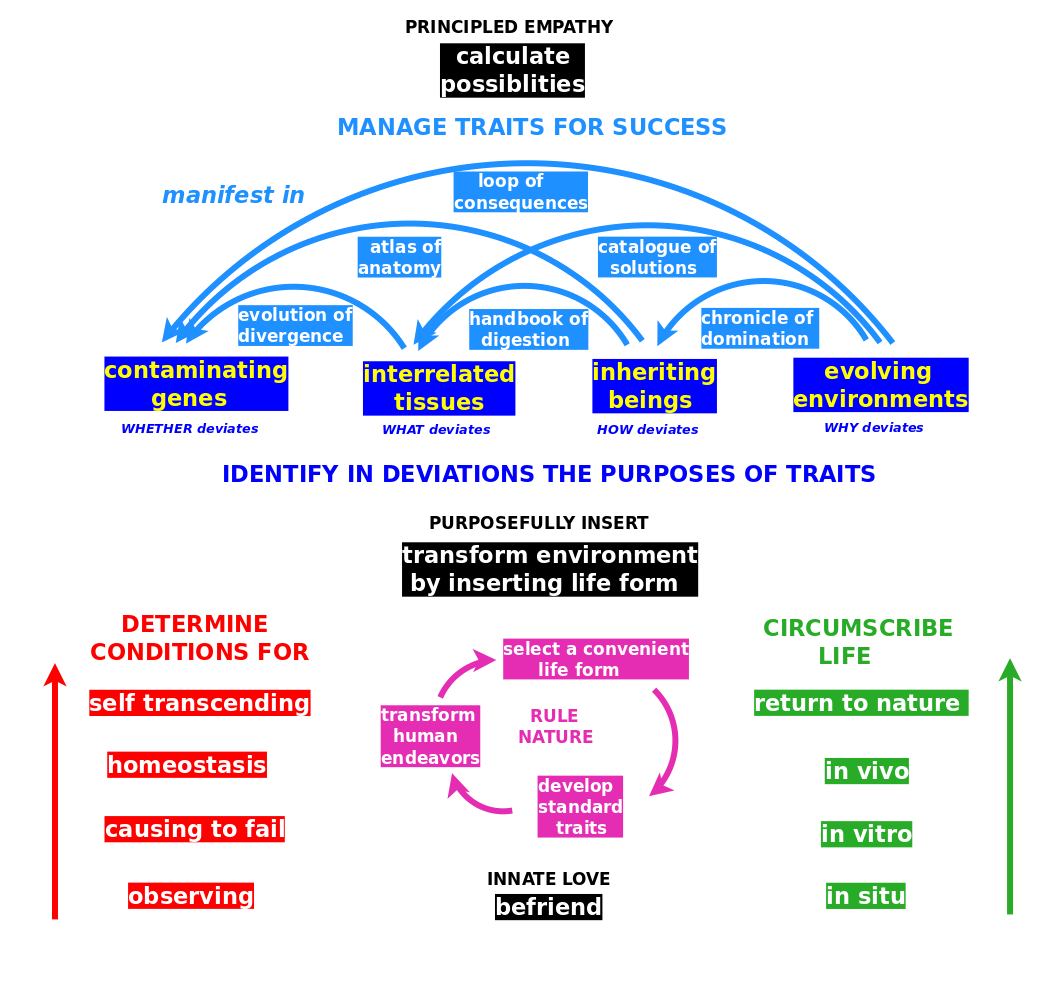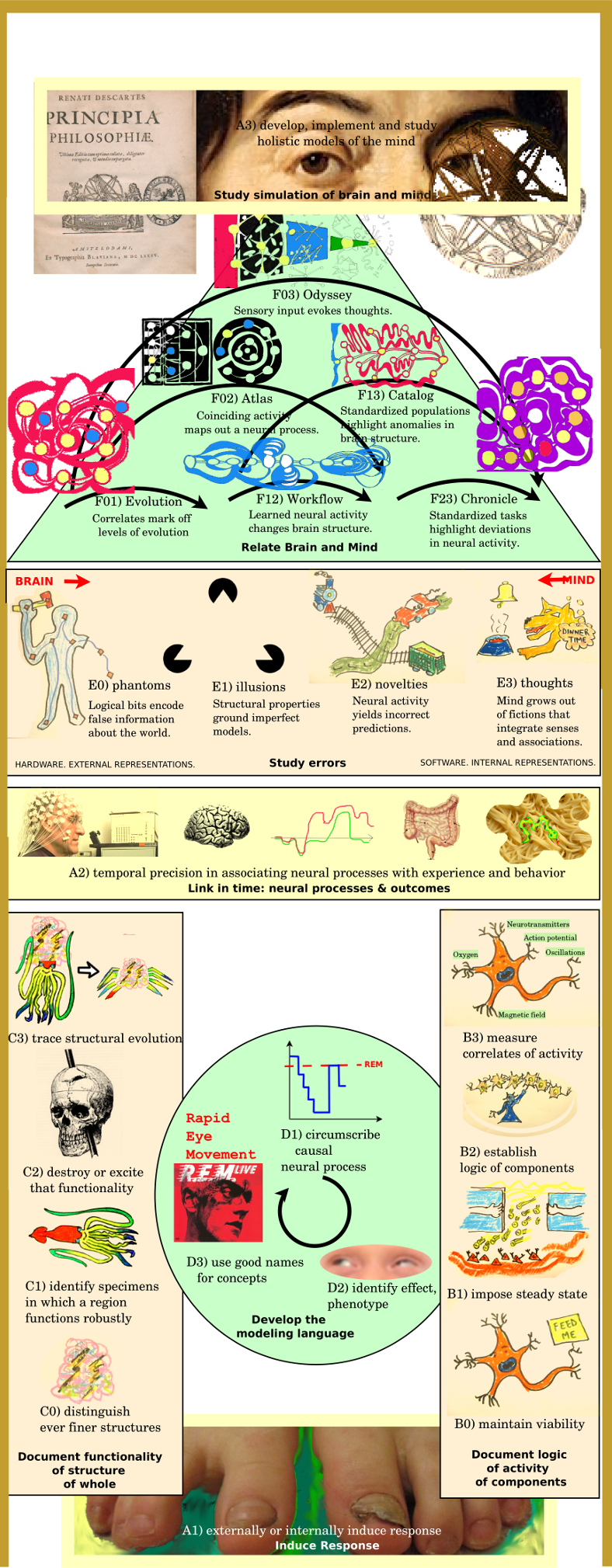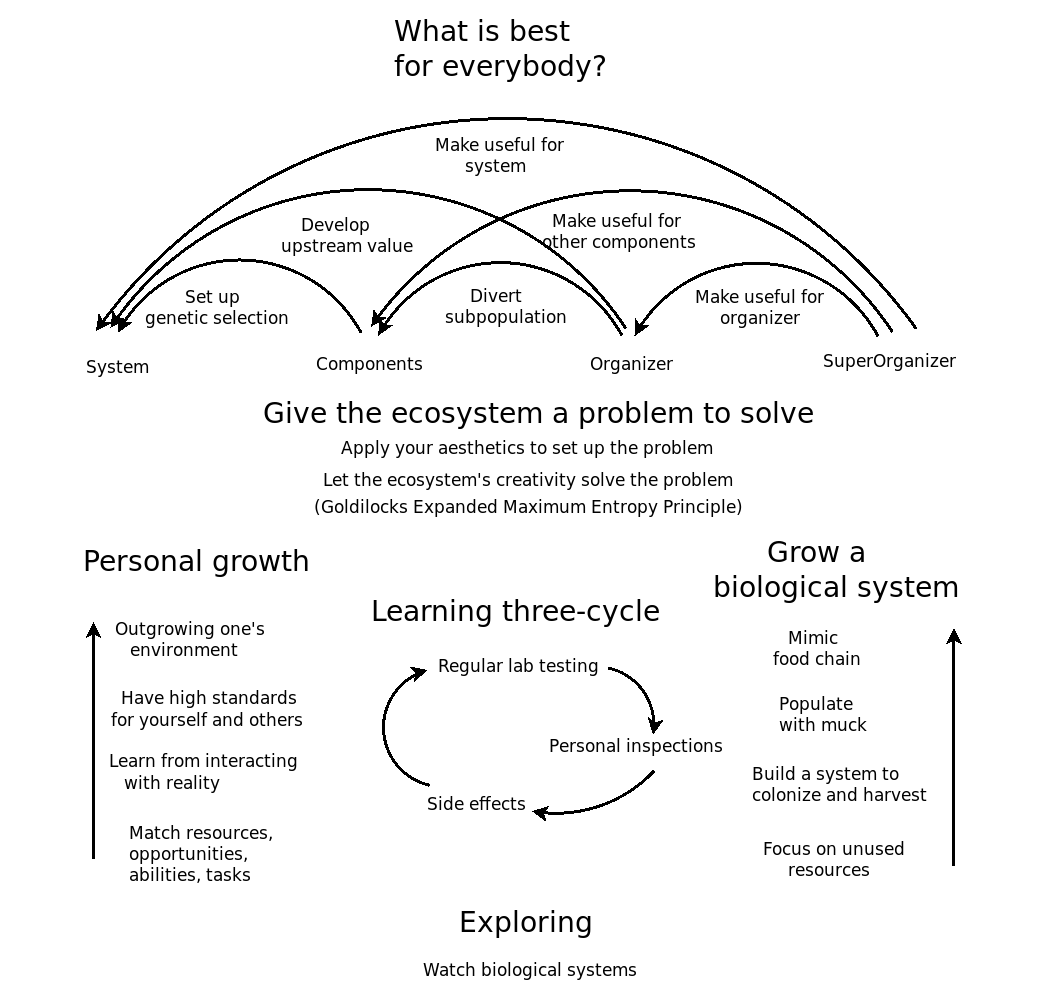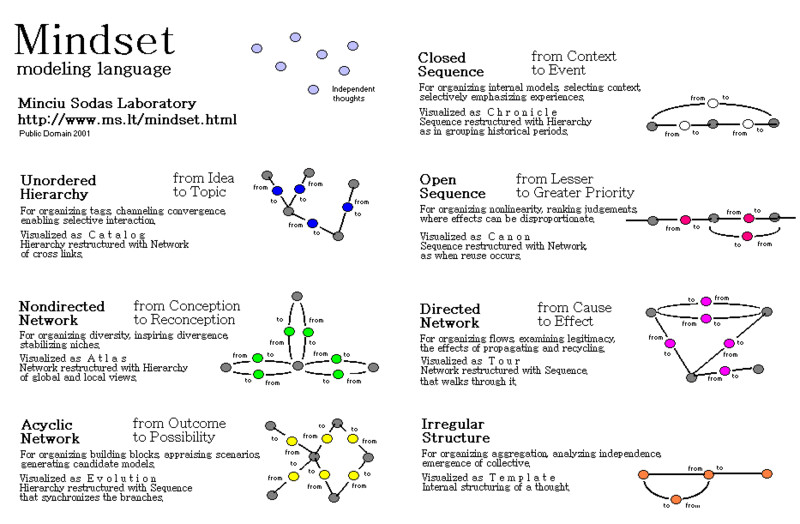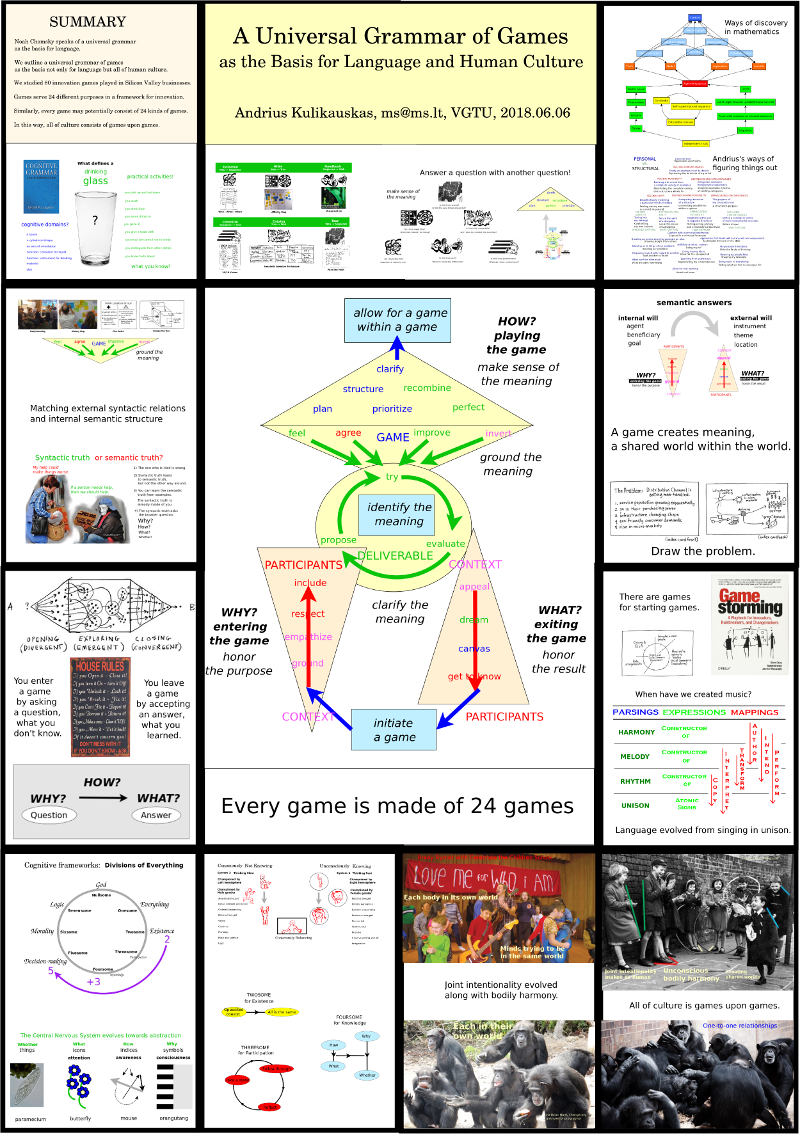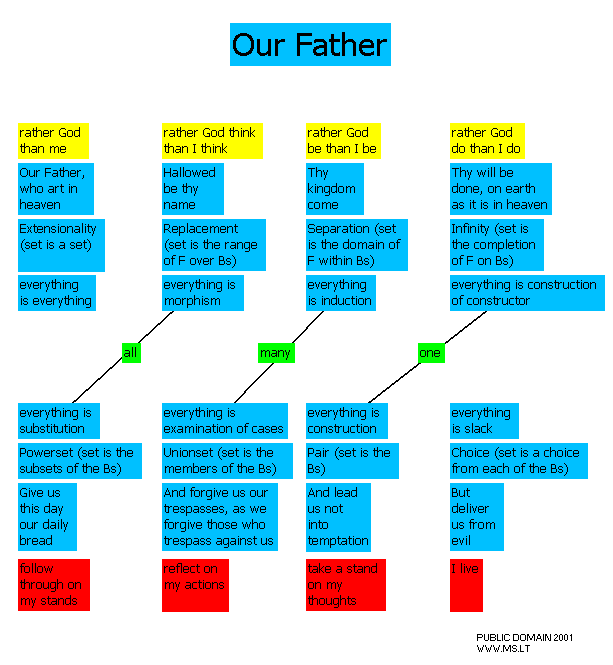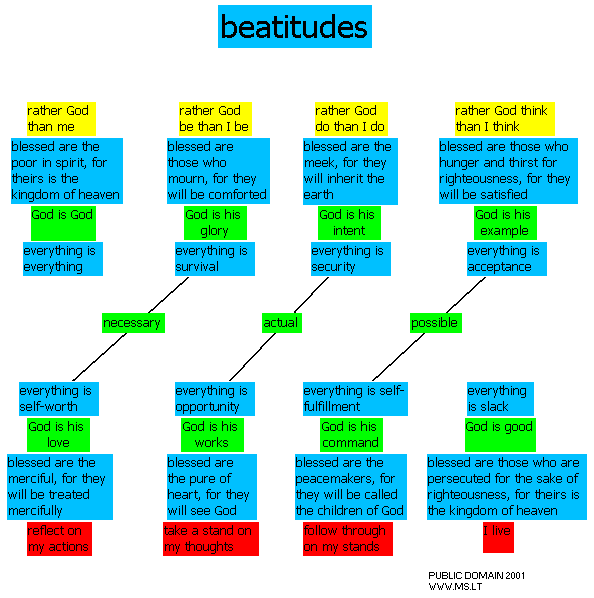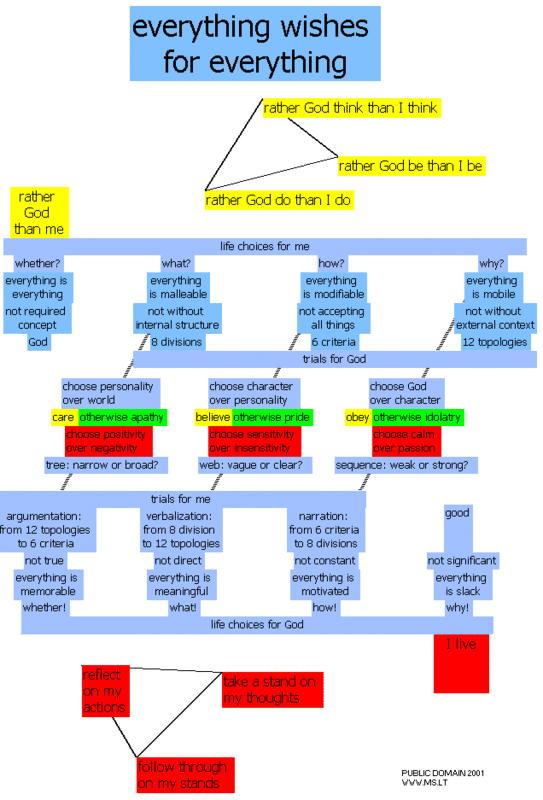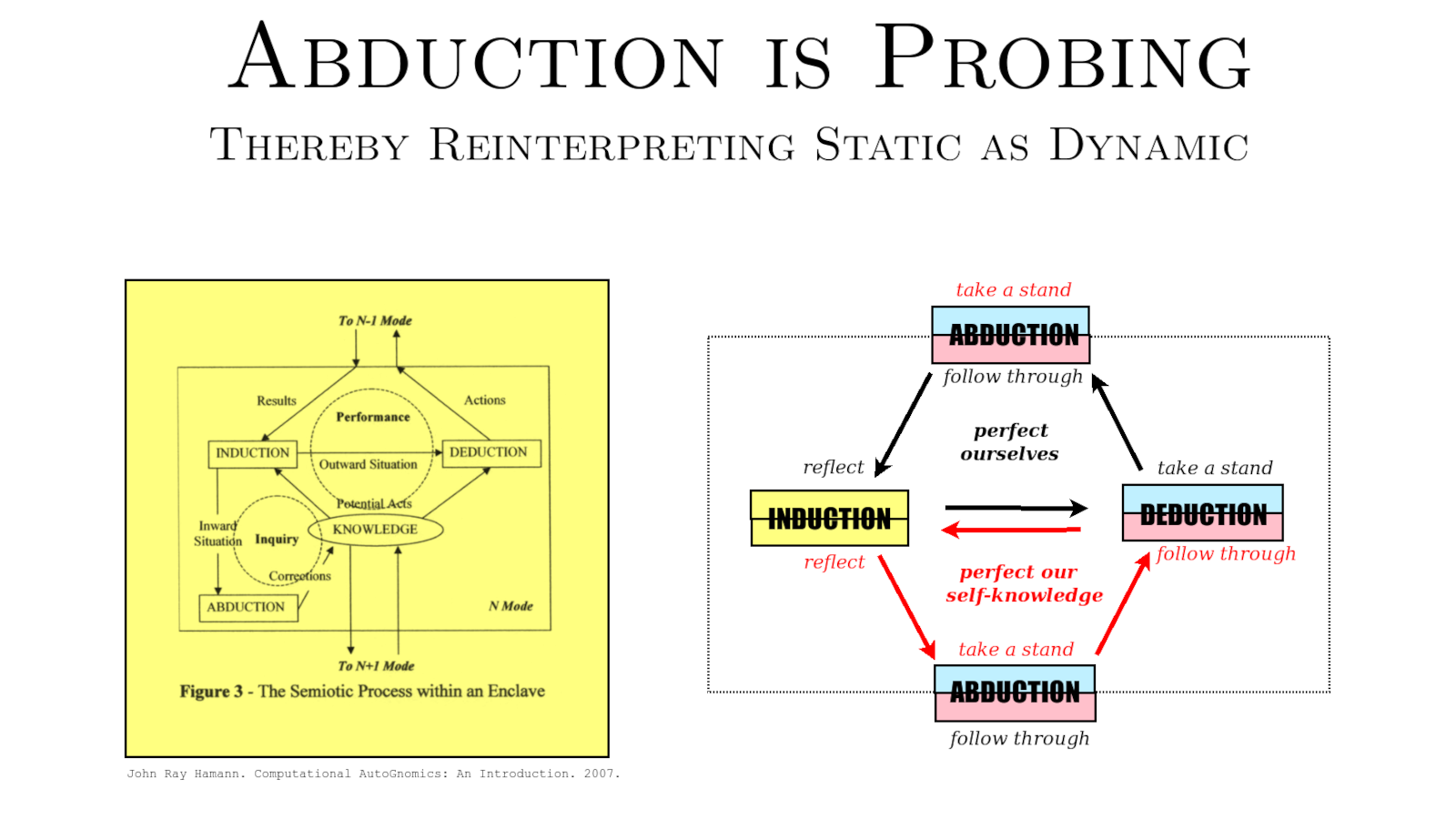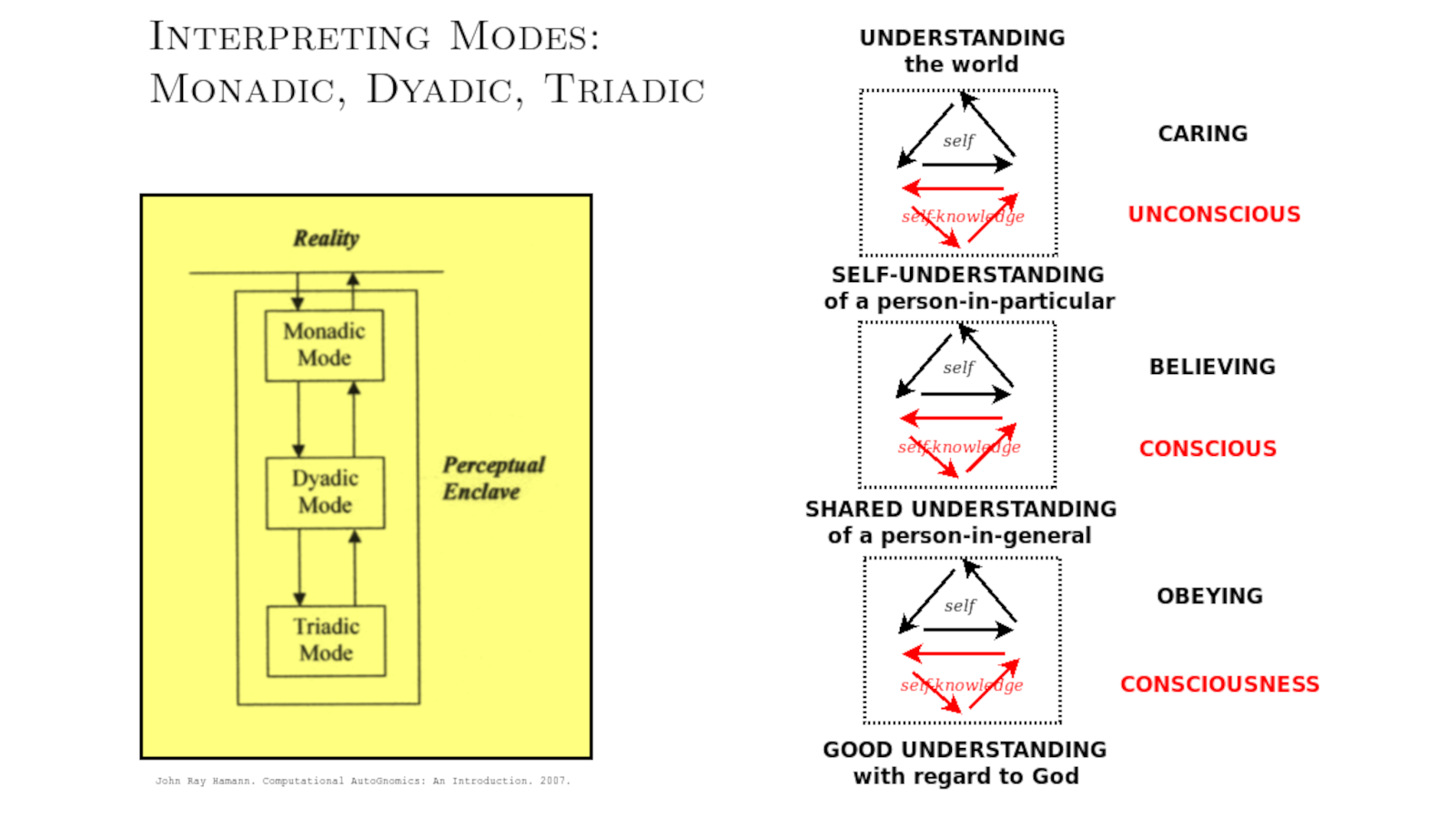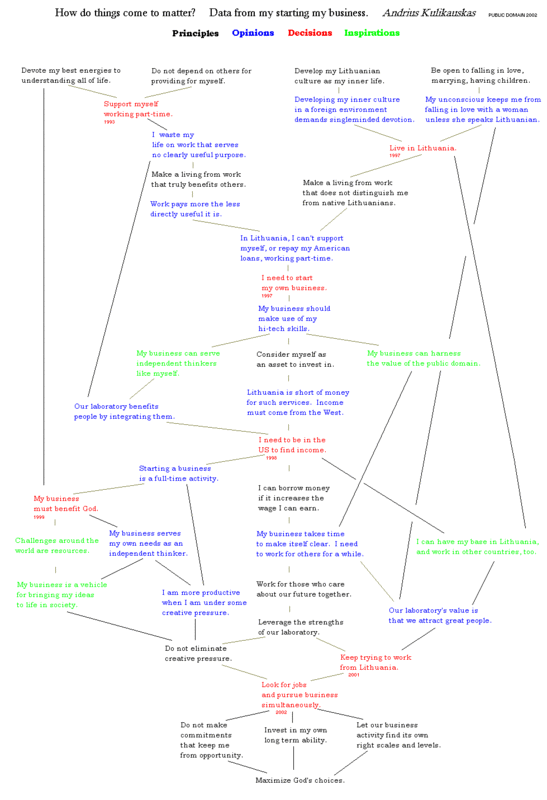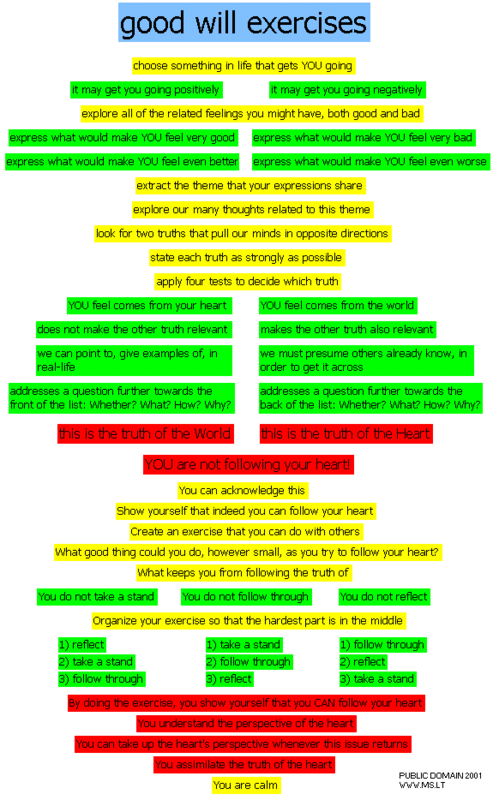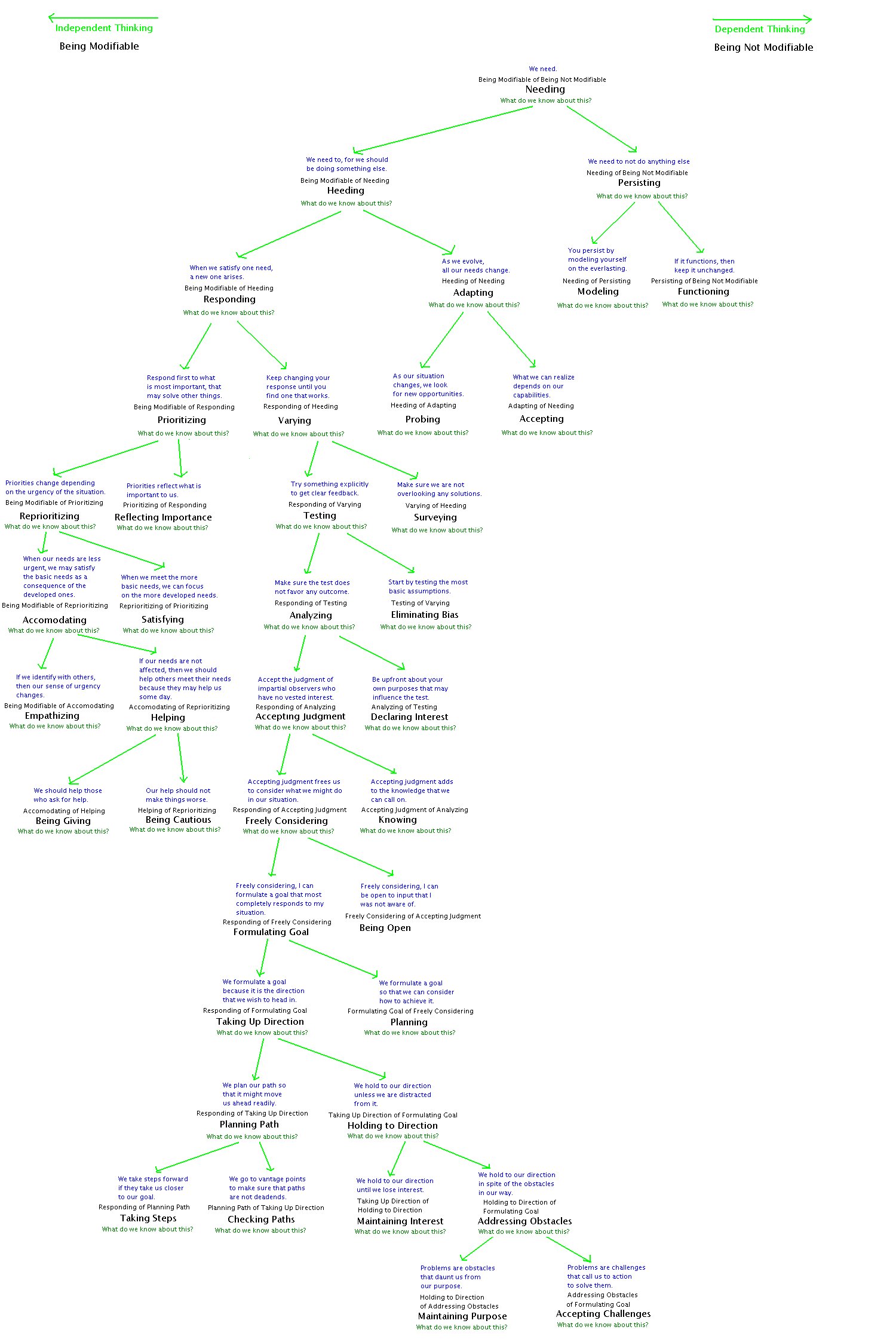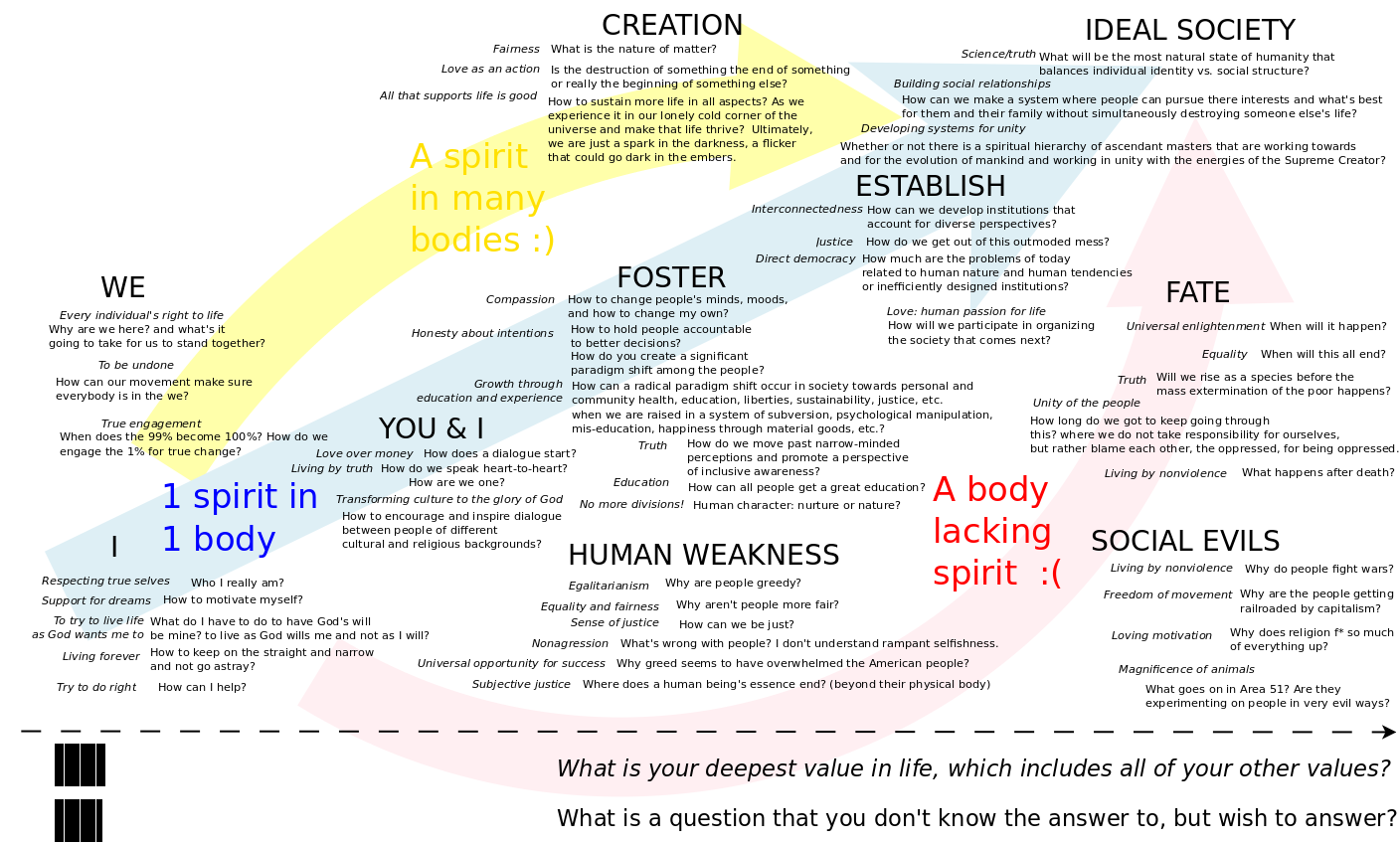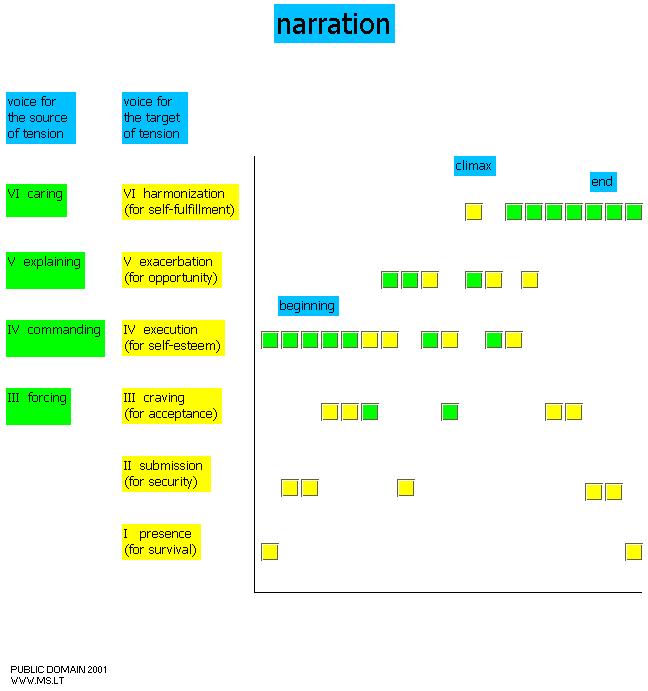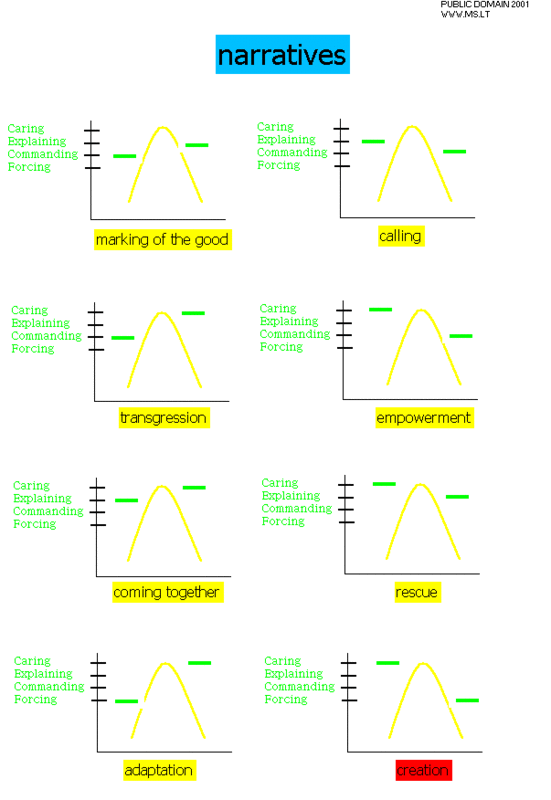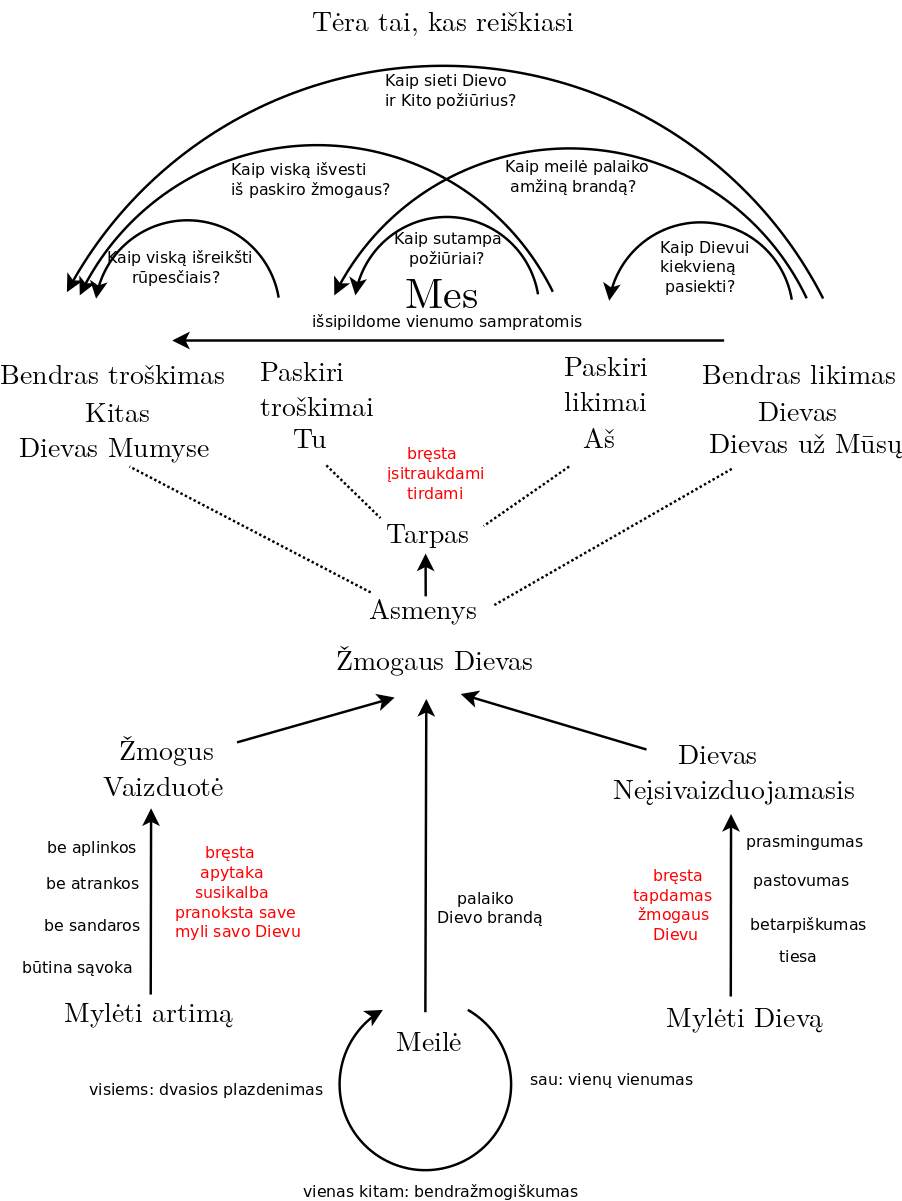Jere Northrop and Andrius Kulikauskas lead this Math 4 Wisdom study group
More Links
Andrius Kulikauskas: These are my notes for my investigation of three conceptual languages: Argumentation, Verbalization, Narration.
How can we model the dynamics of our inner life?
Three Languages: Argumentation (Unconscious), Verbalization (Conscious), Narration (Consciousness)
- Argumentation, the language of the Unconscious, formulates answers and thus explains How do issues come to matter? and allows for caring.
- Verbalization, the language of the Conscious, formulates questions and thus explains How do concepts get their meaning? and allows for believing.
- Narration, the language of the Consciousness, formulates investigations and thus explains How do events happen? and allows for obeying.
- The Unconscious is the mind that knows the answer. It speaks for a world of almost 100 billion neurons.
- The Conscious is the mind that does not know but asks questions. It speaks for a language of perhaps 100 thousand concepts.
- Consciousness is the mind that keeps the Unconscious and the Conscious distinct until the latter's conceptual model matches suitably. It leverages zero to seven perspectives.
In 1987-1988, I hypothesized these three languages as arising from three variants of what I call the Eightfold Way. In 1988-1989 and 1993, I worked out a satsifactory theory for the language of Narration. But I was unable to make progress on Argumentation and Verbalization and thus focused on getting a better understanding of the big picture. In subsequent decades, I drew the distinction between the Unconscious, Conscious and Consciousness.
My Relevant Writings
3 Languages
- Abstract: Pragmatic Constraints for the Foundations of Language
- Santrauka: Išgyvenimų kalba: Sąmonės išplėtimas pasąmone, šneka ir tikrove (Abstract: Language of Experiences: The Expansion of the Conscious By Way of the Unconscious, Conversation and Reality)
Argumentation
- A Cognitive Framework for the Quality Without a Name, Patterns and Pattern Languages, and the Properties of Life
- Kaip pokalbiu atsisakyti paminklinių vaizdinių 1941 m. lietuvių tautos valios reiškėjams nusikaltusiems žmonijai (How to Remove, By Way of Dialogue, Memorial Images of Those Who Expressed the Will of the Lithuanian People and Committed Crimes Against Humanity)
- Kūrybos tikslas – gyvybė, o vaisius – ramybė (Life is the Goal of Creativity, Peace is the Fruit)
- Asmeninė vertybė, ją ryškinantys klausimai ir mūsų gyvenimo rūpesčiai (What One Personally Values, the Questions Which Bring That Out, and Our Concerns in Life)
- Išminčių ugdymo galimybės vartotojiškoje visuomenėje (The Possibilities of Cultivating Sages in a Consumer Society)
- Environment as Spiritual Capital: An Argument for Restoring Vilnius's Oldest Jewish Cemetery
- Abstract: A Baltic Concord (ABC) for Legend Makers with Special Regard for Relationships in Time and Space
Verbalization
- Ironija Holokausto kaltininkus pažinojusiųjų atsiminimuose (Irony in the Memoirs of Those Who Knew Perpretators of the Holocaust)
- Abstract: Coordinating Activities with a Grammar of Self-Transformations
- Musical Activity as the Basis for the Evolution of Joint Intentionality and Nonlinear Grammar
- 20180626VariablesA Structural Semiotic Study of How We Use Variables in Math and Logic?
- Leonard Bernstein's "Unanswered Question" Inspires Questions About the Origin of Games, Music, Language and Humanity
- Abstract: Choosing What We See: Cropping Hitler Out of Lithuania's 1941 Uprising
- Kas jaudinasi, klysta (The one who feels riled is wrong)
- Matematikos grožis žadina vaizduotę (Mathematical Beauty Awakens the Imagination)
- Kūrybos prasmė ir meno taisyklės (The Meaning of Creativity and the Rules for Art)
- Dievo žodžio skaitymas ir rašymas (Reading and writing the word of God)
- Santrauka: Požiūrių atsirinkimas: Kaip išsivystė kryptingi, klaidingi ir melagingi požiūriai į 1940-1941 m. įvykius Lietuvoje. (Abstract: Selection of Perspectives: How There Arose Biased, Incorrect and Mendacious Perspectives on the Events of 1940-1941 in Lithuania)
- Santrauka: "Lietuvos žydai nusikalto, tad lietuviai keršijo." Dviejų mitų ištakos K.Škirpos sumanymuose. (Abstract: "Lithuania's Jews Committed Crimes, So Lithuanians Took Revenge." The Origins of Two Myths in K.Škirpa's Plans)
Narration
- A Theory of Narrative Structure Based on a Study of Lithuanian Folk Tales
- Abstract: A Theory of Narrative: How Do Things Happen? Shifts in Tones of Voice.
Research Strategy
Argumentation
I think that argumentation can be understood as the basis for all pattern languages. Each unit of tension is self-standing and requires only one perspective, the Unconscious, which optimizes itself. It unfolds by way of wholeness preserving transformations.
I am studying What is ecological thinking? and trying to express that as a pattern language.
Bott periodicity cycles through the possible contexts for patterns, the ways of relating recurring activity (modeled with a circle), and the structure it evokes (modeled with the foursome, a pair of switches), which channels activity.
Argumentation takes us from 12 circumstances to 6 conceptions (wholes).
Verbalization
Verbalization allows for independent perspectives to work together, in parallel. This requires fragmentation of grounds which come together through modularity of language.
Verbalization takes us from 8 divisions to 12 circumstances (parts).
Data Sources to Study
Formulate a goal that would indicate an understanding of the language.
- Understand the variety of possibilities and how they unfold.
, Argumentation
Consider data sources which show
- how issues come to matter, yet no meaning arises, no events happen.
- how specific answers are formulated.
- there are no questions because they are given, assumed, fixed in stone
- how tension (given by the environment) is optimally relaxed
- memorability: symbols are indices (not icons or things)
- optimization of tension through wholeness preserving transformations
- stability, conditions, boundaries are imposed from the outside by the environment
- we read in what matters to us
- rules of the game are fixed, given by the environment
Analyze the ethics of adopting ecotechnology, developing waste management systems, eradicating extreme inequality
- Develop the ethical reasoning.
- Starting from the simplest squatting to the most elaborate industrial systems.
Chess games - important positionsd
- chess puzzles
- Bobby Fischer's "My 60 Memorable Games"
Synergetics: Excerpts about society where things come to matter.
Pattern languages (Christopher Alexander)
- Pattern language for TimberFish Technologies.
- Pattern language for waste management systems.
- Pattern language for an econet.
- Pattern language for Minciu Sodas.
- Pattern language for Math 4 Wisdom.
Our deepest values
- Our deepest values in life, our relationships with truth and the landscape of truth.
Meaningful experiences and choices
- Our meaningful experiences in life.
- Our life choices, as in establishing Minciu Sodas, Math 4 Wisdom, TimberFish Technologies and so on.
- The philosophical moves that we make in developing our metaphysical systems, our belief systems, our knowledge systems. In particular, document why and how I developed all of the concepts of Wondrous Wisdom.
- The reasons behind the development of geometry and all of mathematics.
Ecological, economic, communicative, moral thinking.
Verbalization
Consider data sources which show
- how meaning arises but not how issues come to matter nor how events happen.
- how questions or variables are formulated.
- how no answer is given
- how tension defuses, emotion finds expression or effect
- how artificial rules lead to tension, how emotion increases, and how the tension is relaxed
- meaningfulness: symbols are icons (not indices or things)
- truths of the heart and of the world
- we write or create the meaning
- stability is imposed by ourselves, our minds, upon our attention, our thoughts
- rules of the game are created and modified
Meaningful experiences and choices
- Competing truths: The truths of the heart and the world. We can study what sharpens the distinctions between a truth of the heart and the corresponding truth of the world, where every part of the statement has a counterpart in the opposing statement. Together the two truths lead to a topic, which is what gets verbalized. And we can study how the verbalization is grounded in the parts of the statements. And study how meaning arises in each statement.
- Our meaningful experiences in life.
- Our life choices, as in establishing Minciu Sodas, Math 4 Wisdom, TimberFish Technologies and so on.
- The philosophical moves that we make in developing our metaphysical systems, our belief systems, our knowledge systems.
The questions I ask about concepts
The psalms
- Ways of imagining God, yielding 12 circumstances, as verbalization should yield.
The ways of figuring things out in language learning.
- This could include learning foreign languages but also programming languages or chess.
Mathematics
- The possible concepts of triangle geometry, including triangle centers.
- Synergetics: How meaning arises in mathematics.
Wittgenstein's thoughts on how words come to mean what they mean, and how their meanings change.
Biochemistry as a language that we can learn
Examples of irony
- Examples of irony from memoirs that, often unknowingly, describe the lives and thoughts of Lithuanian perpetrators of the Holocaust.
Changes, growth in self-identity
Terms and their underlying activity
- Games
- Recurring activity as the basis for the meaning of words, phrases, concepts. Linguistic activity understood as games.
- Vocabulary of chess
- Terminology of mathematics, the names we give to concepts, structures, theorems, questions, problems and so on.
- Names and conventions and uses for variables.
- Ododu.
- Word formation.
- Music.
- Prayers.
- Humor.
- Behavioral norms, social norms. The unverbalized.
Narration
Consider data sources which show how investigations are formulated.
- A collection of 60 Lithuanian folk tales.
Our investigations
- Our investigatory questions.
- Our ways of figuring things out.
- Our ways of learning. Think of natural language syntax as arising from strategies for teaching and learning what a word means. Thus these strategies can be assimilated over time, without knowing a grammatical system in its entirely. The grammatical system is simply a consequence of these learning strategies.
Systematizations of the Ways of Figuring Things Out
Three Minds: Unconscious, Conscious, Consciousness
Each language focuses on a quality of signs, specifically, grounding arbitrary symbols.
- Argumentation, the language of the Unconscious, focuses on the memorable, whereby caring references an index with a symbol (issue).
- Verbalization, the language of the Conscious, focuses on the meaningful, whereby believing references an icon with a symbol (word).
- Narration, the language of Consciousness, focuses on the significant, whereby obeying references a thing with a symbol (event).
We experience by way of God's in three different scopes.
- Our consciousness is self-sufficient, wishing for nothing. It is self-contained, relating the conscious and the unconscious.
- Our conscious is certain, wishing for something. It holds open a window.
- Our unconscious is calm, wishing for anything. It is a self-balancing web of cycles that persists in changing environments.
This suggests that we identify God with Consciousness that goes beyond itself into itself, yielding a God who wishes for everything, is loving. Such a God is embodied in a loving world.
Six secondary structures arise through empathy, that is, from God's wishes taking up human's not wishes.
- 8 divisions of everything. Self-sufficient consciousness takes up counterquestions.
- 6 divisions of everything. Self-sufficient consciousness takes up emotional responses.
- 12 circumstances. Certain conscious takes up emotional responses.
- Language of argumentation. Calm unconscious takes up eightfold way.
- Language of verbalization. Certain conscious takes up eightfold way.
- Language of narration. Self-sufficient consciousness takes up eightfold way.
Units of Tension
- Argumentation. For the Unconscious mind, the unit of tension has a single constituent, which represents itself, its own growth. Tension arises in applying a pattern. It is resolved upon optimizing that pattern. Tension is given by stillness, which appears at four different levels, and which the pattern structures. The stillness arises naturally but fleetingly so it can be maintained so that it persists. In that sense it is like the positive emotion, which is immortalized by virtue.
- Verbalization. For the Conscious mind, the unit of tension has two constituents, which represent the Conscious and the Unconscious. Tension arises from confusing the truth of the heart and the truth of the world, which makes us riled (when we think wrongly), negative (when we do wrongly), and insensitive (when we are wrongly). The Unconscious is understood to be generating tension by way of emotion that it communicates to the Conscious. The tension is resolved when the Conscious embraces the truth of the heart.
- Narration. For Consciousness, the unit of tension has three constituents. The Unconscious is understood as the target of tension, the Conscious is understood as the source of the tension. Consciousness is a third voice which resolves the tension by siding with one side or the other. (We thereby consciously step in or step out.) Tension is felt as emotion by which the Unconscious speaks to the Conscious, and it is resolved when the Conscious constructs a model that is appropriate, according to the Consciousness, which then imposes the cognition.
Organizing the Units of Tension
- Argumentation. Units of tension are organized in a network.
- Verbalization. Units of tension are organized in a tree (a network without cycles).
- Narration. Units of tension are organized in a sequence (a tree without branchings).
Narration (as a sequence) may be the foundational language, with verbalization (as a tree) and argumentation (as a network) being commentary about that, for example, pointing to the climax or to the stability of the voice of the source of tension or the bell curve of the target of tension.
Visualizations
The Conscious (small conceptual language) restructures the Unconscious (large neural world)
Visualization as Restructuring and thus a Source of Logical Paradox
Verbalization
- The Mindset standard considered how visualizations provide a semantic context, as in the diagram below. Explore what role this semantic context plays in formulating concepts.
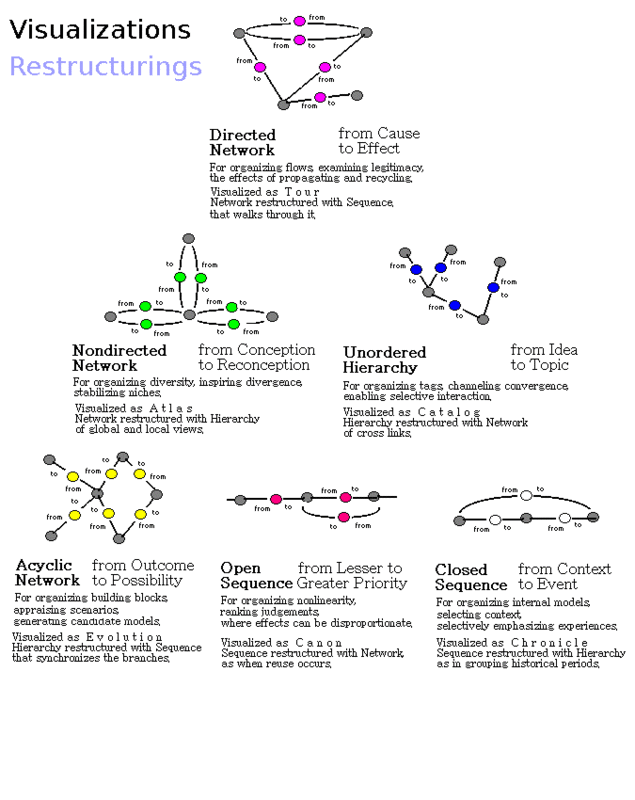
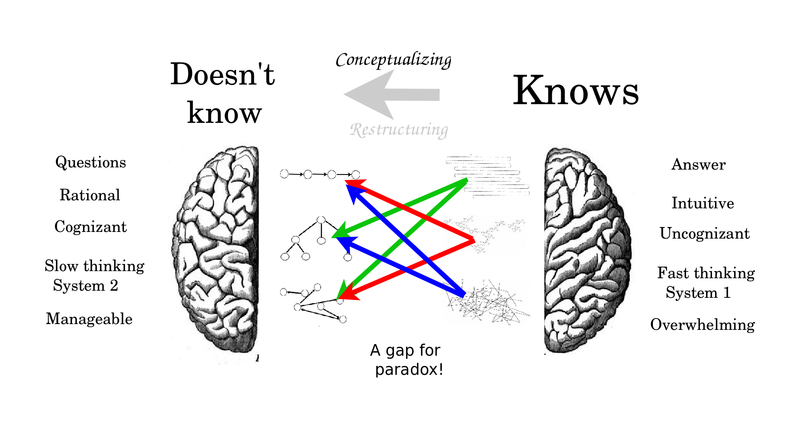
Structural Systems
- Argumentation lets us care by constructing a system of concerns expressing the Unconscious. This system is a web of cycles of recurring activity. Cycles circulate the tension.
- Verbalization lets us believe by constructing a system of beliefs expressing the Conscious. This system is a statement of belief that is a tree of concepts of beliefs. The tree harmonizes the tension.
- Narration lets us obey by constructing a system of findings expressing Consciousness. This system is a sequence of experience of the creation and relaxation of tension.
Variants of the Eightfold Way
The eightfold way is the framework for these languages. It describes how we construct values as an alternative to love. Thus it relates the human will with God's will. Each language arises from God empathizing with us through God's wishes for nothing, something and anything.
- God wishes for nothing, is self-sufficient, and as such his empathizing with the eightfold way yields narration.
- God wishes for something, is certain, and as such his empathizing with the eightfold way yields verbalization.
- God wishes for anything, is calm, and as such his empathizing with the eightfold way yields argumentation.
Thus
- Argumentation speaks to God's peace and our expectations, our heart, our emotional life.
- Verbalization speaks to God's certainty and our doubts, our mind, our cognitive life.
- Narration speaks to God's self-sufficiency and our needs, our bodies, our physical life.
Preliminaries
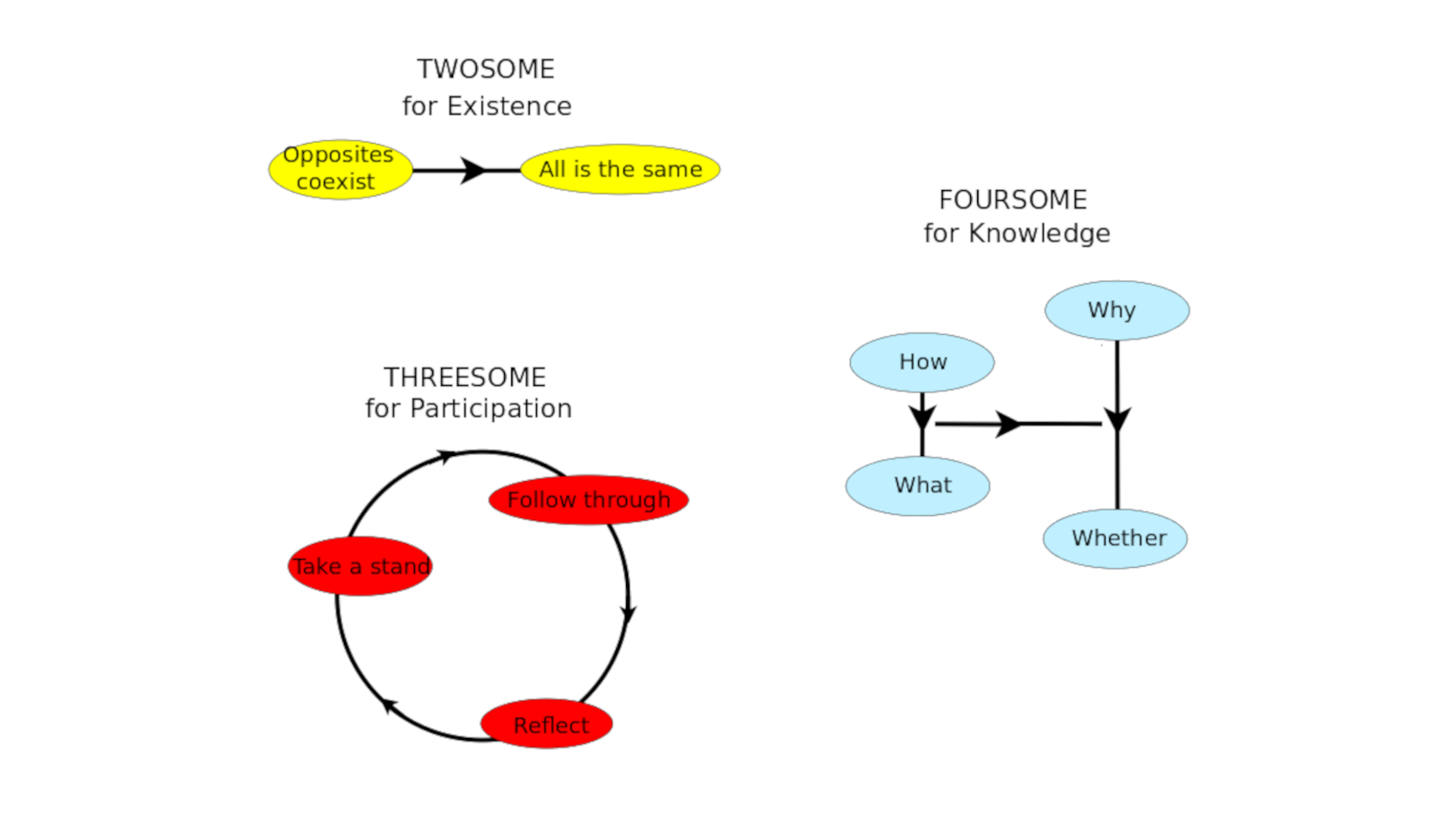 | 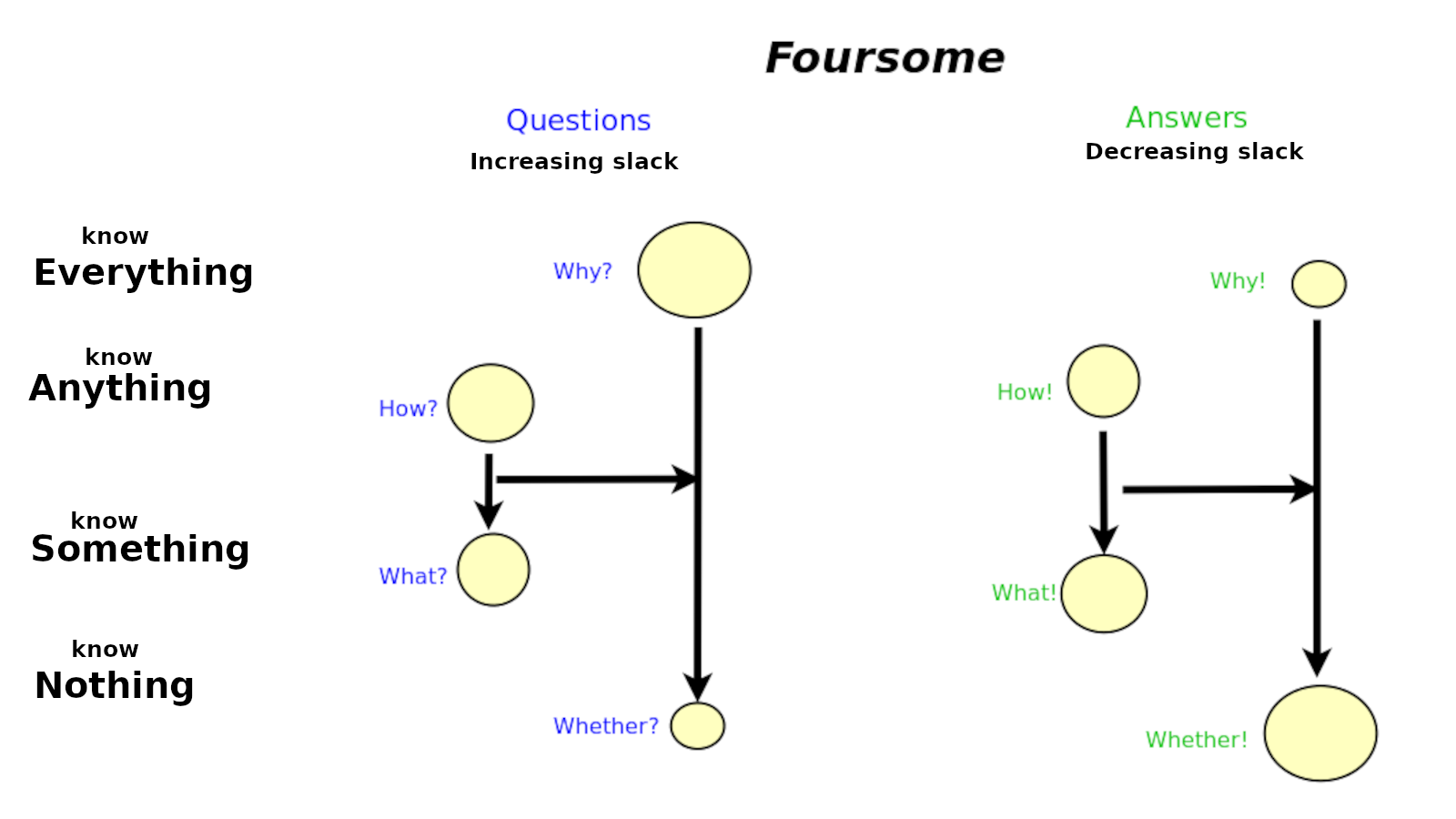 | 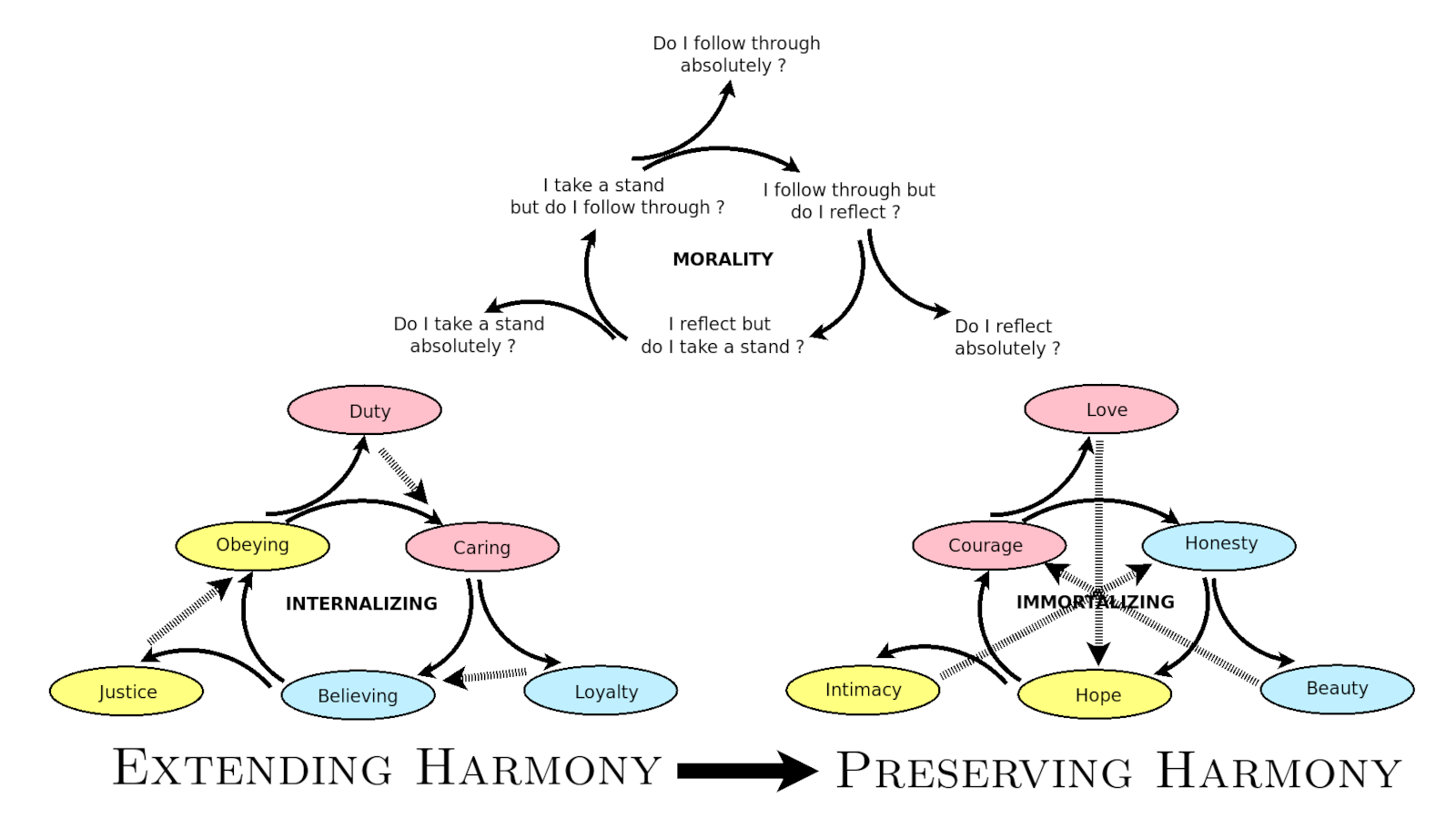 |
Argumentation
Verbalization
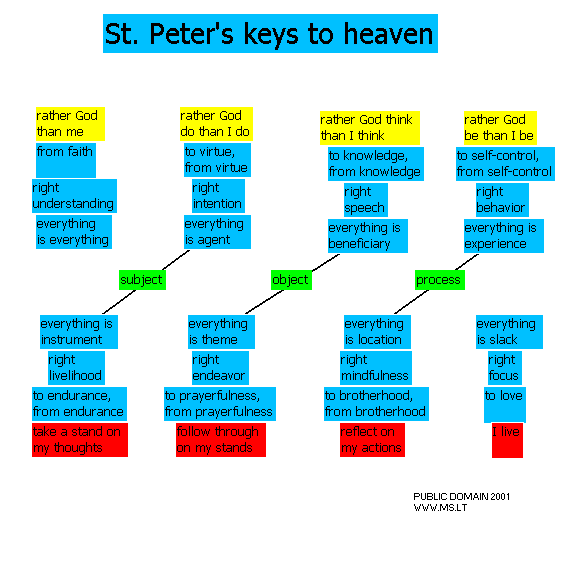
Narration
General form
Octonions
Image from John Baez's website
Interpreting the AutoGnome
Interpreting the AutoGnome Chain
Shifting From One Structural Family to Another
Argumentation
- From 12 circumstances to 6 conceptions.
- Relates what is true (obvious) and what is not.
- God who is at peace (wishes for anything) interprets the Eightfold Way (God's will)
- Grounds conceptions for the Unconscious in terms of circumstances for the Conscious.
Verbalization
- From 8 divisions of everything to 12 circumstances.
- Relates what is direct and not.
- God who is certain (wishes for something) interprets the Eightfold Way (God's will)
- Grounds circumstances for the Conscious in terms of divisions for Consciousness.
Narration
- From 6 conceptions to 8 divisions of everything.
- Relates what is constant and not.
- God who is self-sufficient interprets the Eightfold Way (God's will)
- Grounds divisions for Consciousness in terms of conceptions for the Unconscious.
Gradations
Argumentation
Methods of mathematical proof. Evidence of God.
- morphism - translation of terms - God's name
- induction - spreading of culture by participants - God's kingdom
- construction of constructor - forming of one's will - God's will
- substitution - investing a term with meaning and value - as with our daily bread - God as giver
- examination of cases - distinguishing and managing domains - so that sins can be forgiven - God as manager
- construction - separating out from the environment - safeguarding from temptation - God as circumscriber
The first three levels are outside of any system and the next three levels are within a well founded system. Together they define the boundary between the presystemic world within and the systemic world outside.
This gradation is relevant for the Unconscious, its calm, and relates to the framework for expectations, emotional responses and directions to and from the good.
This gradation also sets up the Kiparsky hierarchy, which describes the thematic roles by which this evidence is provided.
Verbalization
Kiparsky hierarchy
- agent
- beneficiary
- experience / goal
- instrument
- patient / theme
- location
This gradation is relevant for the Conscious, its certainty, and relates to the framework for doubts (like, need, real, problematic, reasonable, wrong).
Narration
Needs
- survival
- security
- social
- self-esteem
- freedom / opportunity
- self-fulfillment
This gradation is relevant for Consciousness, its self-sufficiency, and relates to the reservation in terms of needs and operating principles to address them. The unconscious addresses the need to survive, thus cling to what we have, the conscious addresses the need for security, regarding what we don't know, thus getting more than what we need, and the consciousness addresses the social need, avoiding extremes. Likewise for self-esteem (unconscious), freedom (conscious) and self-fulfillment (consciousness).
Data analysis: Argumentation
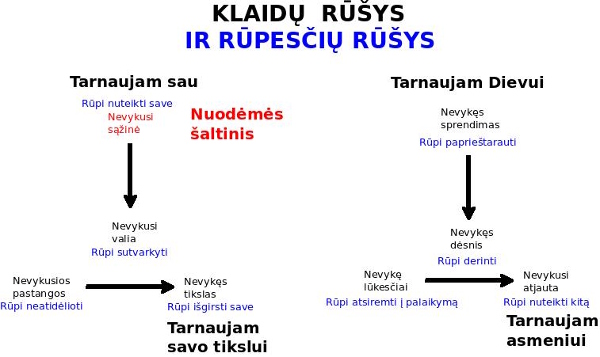
There are four mistakes (discrepancies) of the Unconscious and four mistakes of the Conscious. They are the sources for eight concerns that arise, regarding what matters.
- I can maintain a state Z. be; refuge for spirit
- There are situations where I can address Z. do; opportunity to do good
- Freedom is needed to resolve Z. think; good heart
- Others have it different than me with regard to Z. one; existential question
- I need to consider everybody regarding Z. all; collaborating fate
- I can complete Z. many; peace
- I focus on the essence of Z. object; knowledge from obedience
- I admit my dependence regarding Z. process; duty to obey
- I may wrongly pursue Z. subject; answered prayer
- I am unrestrained with regard to Z. necessary; limits of mind
- I take partial responsibility for Z. actual; inhuman wisdom
- I must appreciate the opportunity of Z. possible; self-contradiction
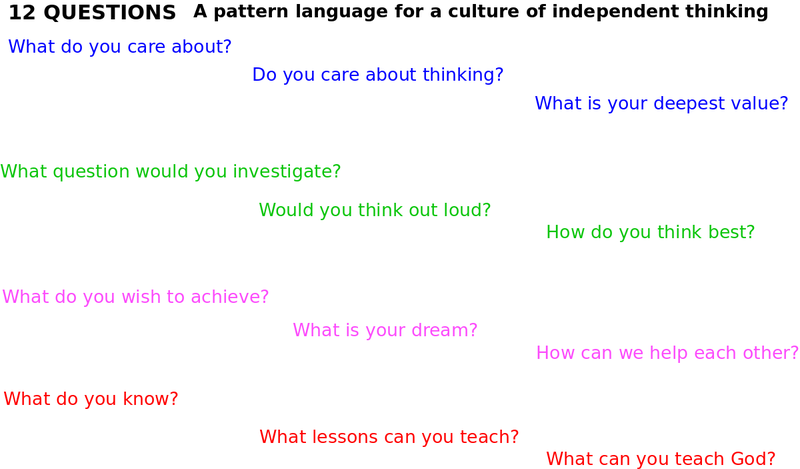
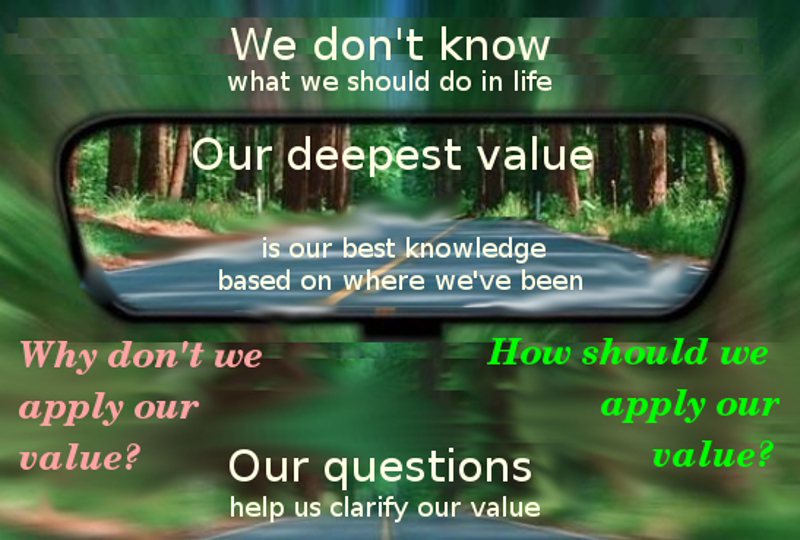
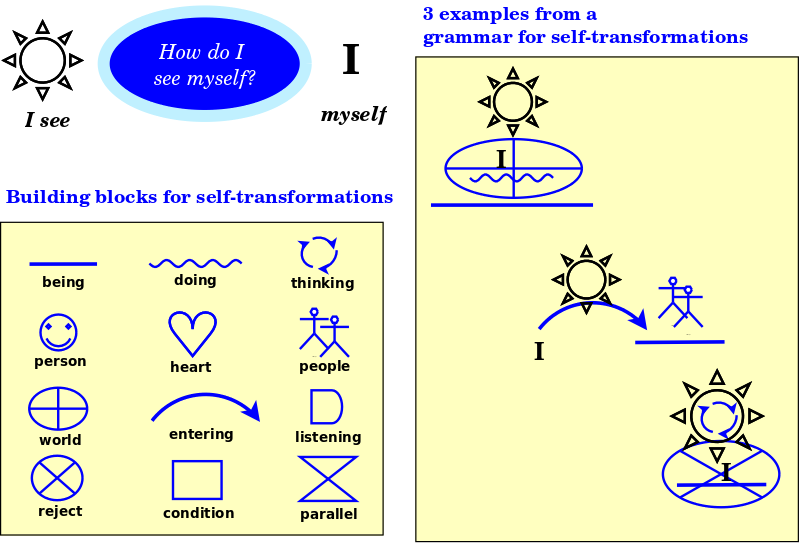
Investigatory Workshop: How does my self-identity change?
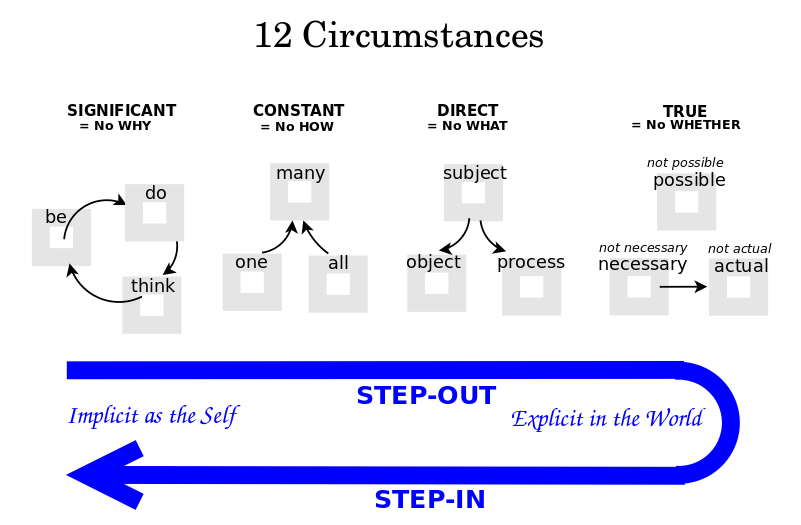
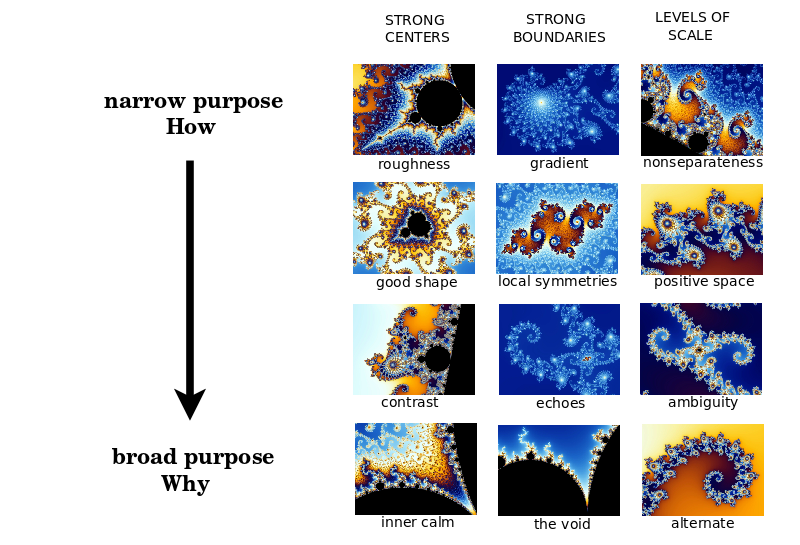
Lietuvių ir litvakų šimtametis vaidas, 1940-2040 m. Dorovinis tyrimas.
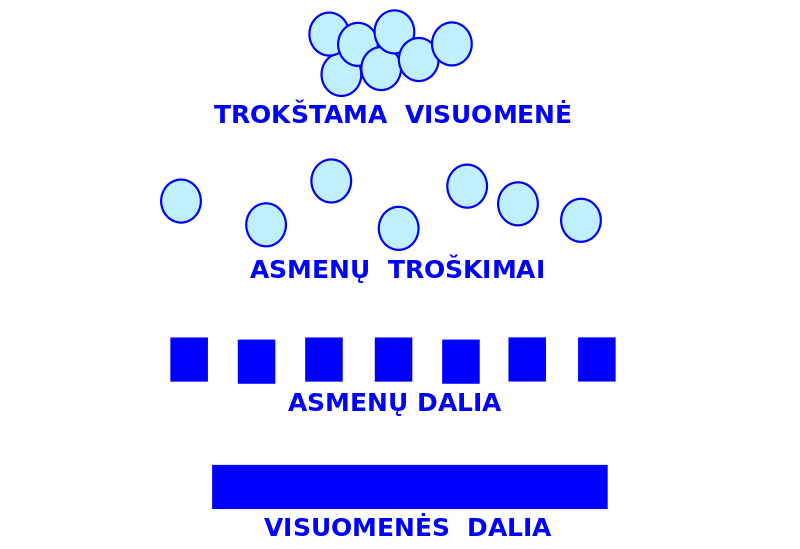
Data analysis: Verbalization
- Consider the role of the divisions of everything as input. Note that the doubts and counterquestions relate the truths of the heart and world, the four levels of knowledge by which the topic can be understood.
- How do the doubts relate to the Kiparsky hierarchy of agency?
- There are four levels of knowledge. So what could be the roles of increasing and decreasing slack?
Given any issue that riles, any "hot button" topic such as "climate change", the underlying topic may actually be very different for different people. So I would ask them questions about the topic:
- What makes you feel bad? and what would make you feel worse?
- What would make you feel good? and even better?
That would yield two double statements where all four parts would typically have the same meaning (ignoring the positives and negatives). That meaning would be the deep issue, the subject to consider. And then regarding that subject I would ask, what is true about that? And there would always be two truths, pulling in opposite directions. The person who was riled was inevitably giving priority to "the truth of the world", confusing it for the "truth of the heart". Both are true but it is the latter that is relevant. So thinking anew about this, the Unconscious shows the divergence on the topic as regards feelings, and the Conscious shows the divergence as regards truth. But all four flow from the meaning, as given by the expression, the deep topic. So I believe this is very much the catalytic structure for giving meaning to words or phrases or expressions. And I expect from the mechanics of Wondrous Wisdom that each such set up will yield one of 12 circumstances (be, do, think; one, all, many; object, process, subject; necessary, actual, possible), which are similar to Kant's 12 categories. I imagine that "necessary" "actual" "possible" introduce totally new concepts whereas the others reinterpret, relive exisitng ones in new ways. So the setup is applying a new circumstance upon the existing expressions to establish a new meaning. Which is to say, there should be 12 ways to build upon the old expressions, and there should be some constraints that I hope to work out, studying the data that I have. If we set up more exercises, then we would have more data.
Input of the Language
The input of the language derives from the source of tension.
Argumentation
The single-component tension, the self-tension of the unconscious, manifests as stillness on four levels. The stillness is grounded by triples of circumstances, which is to say, by conceptions of the threesome.
Every pattern works on four levels: recurring activity, structural solution, competing forces and optimized preferences. There are eddies of stillness within activity, a core of stillness in a structure, a web of stillness across forces, and an overall stillness in the decree of the creator. Thus we have a range of stillness, from narrow to broad, reflecting how God has gone within us and around us from beyond us.
- Truth is the stillness of everything. For truth is what can't be hidden, what will be revealed, what is obvious, which all makes sense in the metalevel. Truth demands that we be rational, give up our emotions and our very selves so that we can weight, without prejudice, God and the individual, what is true and what shows it to be true. If they are one and the same, then truth is necessary; if one follows from the other, then truth is actual; and if what is revealed is their relationship, then truth is possible. If your purpose is necessary, then you get into your role by simplifying; if you want to present reality, then you must free a path, opening up the void; and if you want to open up possibilities, then you alternate extremes. The formal nature of truth means that we are perfectly free to objectively compare opposites, namely, life and love, yang and yin, what is with what is not but makes room for it.
- Directness is the stillness of anything, as in competing forces. Our attention can be directed to something else, an object, but then can become directed to itself, yielding a process. And a subject is the one whose attention is directed. Similarly, your bring out what is unnoticed by contrasting; you lose yourself in the joy of creating by echoing; and you foster sensitivity to feelings by interweaving, thus creating ambiguity.
- Constancy is the stillness of something, such as the core of a structure. Let us search for constancy. Either we find one example of constancy, or we don't, in which case all is constantly unconstant. And each time we select and inspect something, we suppose they stay the same, and so are multiply constant. Thus we define "one", "all" and "many" as circumstances wherein we can imagine stillness, a center, a purpose. You immortalize in a work of art by making a good shape; transform the world by tiling it symmetrically; inspire creativity by dividing space positively.
- Significance is the narrowest form of stillness. No matter how immersed we are in life, we have a speck of stillness from our metalevel. In the spirit of Descartes, if thinking is significant, then being is significant, but then doing is significant, and then again thinking is significant. Our creative purpose may be to be ourselves, and so we create roughly. Or we may live as a tool of art, and so we vary continuously, yielding gradients. Or we may master a conceptual language, and so we respect relationships, and value nonseparateness.
Verbalization
Narration
For narration, the input of the language is the constancy of the source of tension in the beginning of the story (as forcing, commanding, explaining or caring) and likewise at the end of the story (but in a different yet constant tone).
The Shape of the Language
Argumentation
Things come to matter when we internalize and thereby allow for immortalization of that which arises naturally but fleetingly (positive emotion) through that which can support and maintain it (virtue). We internalize the emotional communication, from the unconscious to the conscious, as the cognition imposed by the conscious on the unconscious. Our emotional life is picking up the stillnesses and the variations from them, and that is the source of tension, which the conscious resolves. The emotional life proceeds from whether towards why and cognition responds from why towards whether.
Verbalization
Narration
Narration is a language of investigation in the sense that it does very simple experiments: it communicates to a system by forcing, commanding, explaining or caring, and then switching to a different voice. It thereby investigates the level of consciousness of the entity that it communicates with.
Output of the Language
Argumentation
From 12 circumstances to 6 conceptions.
As cognition is imposed, the scope of knowledge - why, how, what, whether - goes from broader to narrower, establishing 6 pairs of scopes which express the resulting concerns by which we care. These concerns set up the moral structure whereby the broader should be addressed before the narrower.
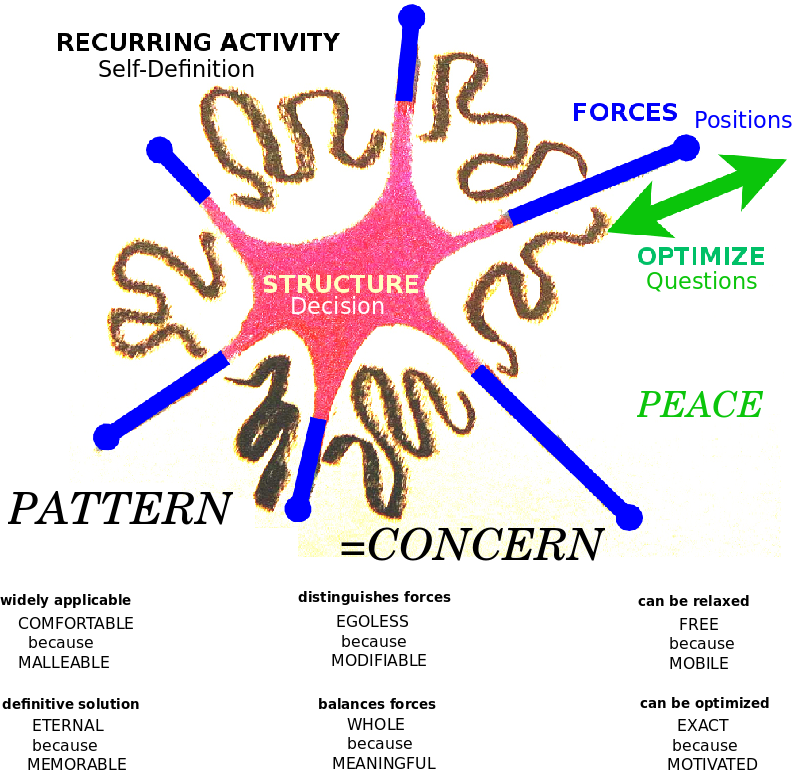
Verbalization
From 8 divisions of everything to 12 circumstances.
Narration
From 6 conceptions to 8 divisions of everything.
The Science of Love
Investigate the science of love as God's investigation in order to understand the eightfold way as Human's investigation.
Questions
- Consider how concepts are defined by the foursome, fivesome, sixsome, sevensome as suggested by my article on Decision-making.
- What gradation organizes the prayer "Our Father"?
Notes
- Visual frameworks connects visualization with semantic contexts such as gravity. Note that gravity is based on a quadratic power law and yields the fivefold conics.
Collecting meaningful experiences in life
- https://www.npr.org/2024/04/30/1247768882/kindness-stranger-help
- Conceptual Mathematics Posina Venkata Rayudu about William Lawvere.
- https://ncatlab.org/nlab/show/Functorial+Semantics+of+Algebraic+Theories
- John Isbell. General Functorial Semantics.
- Functorial Semantics of Algebraic Theories, William Lawvere


